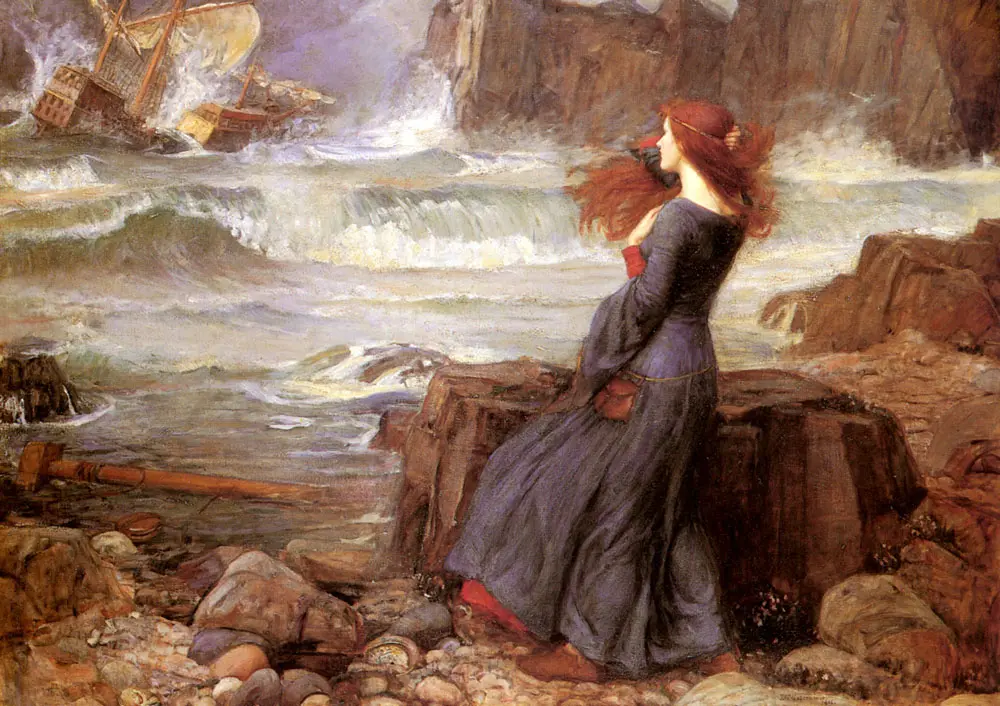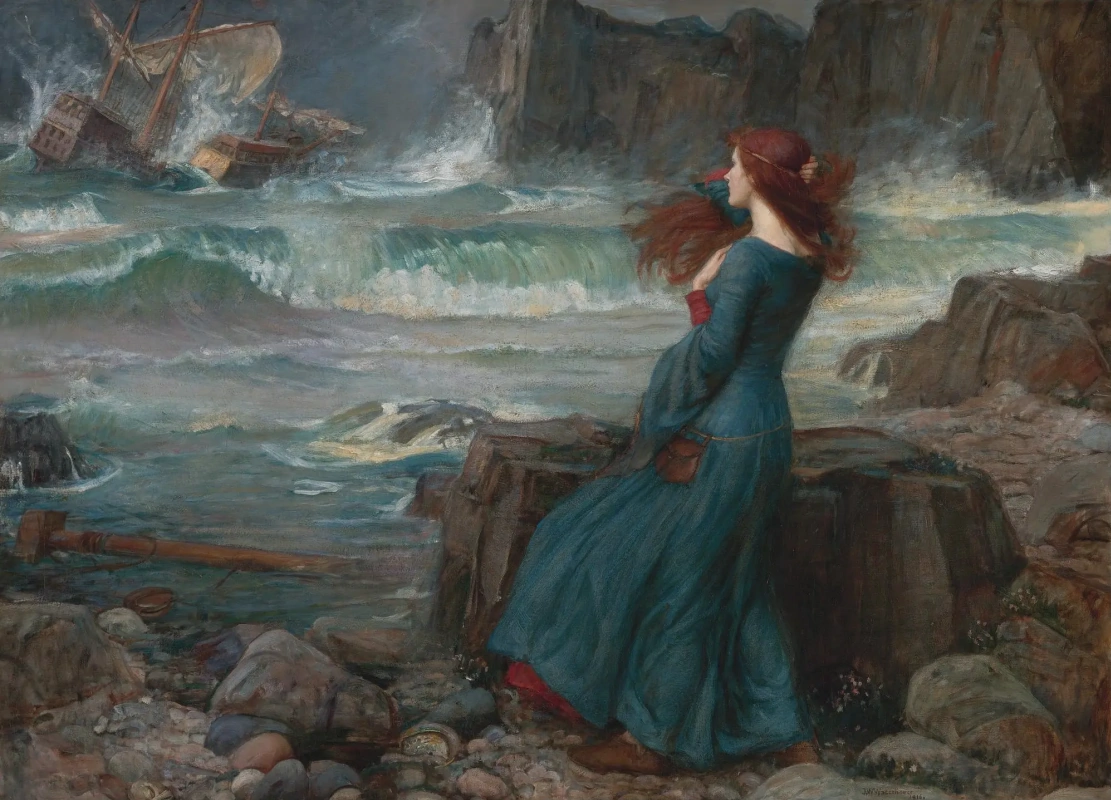log in
Enter site
Login to use Arthive functionality to the maximum
Miranda and the tempest
John William Waterhouse • Peinture, 1916, 110.4×137.8 cm
Descriptif de la toile «Miranda and the tempest»
Miranda is the heroine in one of the later works of William Shakespeare "the Tempest", as well as the image inspired many artists. "Miranda and the tempest" created by Waterhouse in 1916, becoming one of the recognizable of his works and the most popular illustration of the play.
The plot of the play follows the adventures of the magician and Duke of Milan Prospero and his daughter Miranda young. Through family turmoil and the struggle for power, the main character and her father for many years to be a hermit on a desert island. Here Prospero brings his magic arts to perfection, to avenge his brother-the usurper Alonso.
Years later, Prosaro sends a storm to the ship, Alonso, and all who were on the ship die. The son of an enemy, nephew of Ferdinand manages to escape, and he meets Miranda. Girl and boy fall in love, but Miranda's father is experiencing Ferdinand and hides the fact that his father is alive. Thanks to the magic power Prospero, all the misunderstandings come to a positive conclusion: brother recognize his authority, the son meets with his father, and beloved are preparing for the wedding, safely back in the civilized world.
The artist chose for picturesque narrative, the most tragic and touching moment of the entire piece: the death ship of Alonso. Miranda — deep girl, she is struck with pain and helplessness at the sight of the shipwreck and loss of life:
Oh, how I suffered,
The suffering of the dying sharing!
A brave vessel, where, of course, was
Honest and righteous people,
Crashed in chips. In my heart
Sounds their cry. Alas, they died!
Miranda Waterhouse stands alone on the shore of a stormy sea, unable to help the sinking ship. Surrounded by rocks and waves, daughter of the Duke stands as a lighthouse, firmly standing on the ground, like boulders along the shore. The suffering and the despair girls, the viewer can not see: it shows in sex trafficking. But the artist conveyed emotions of Shakespeare's lines through her movements and color: Miranda holds the flowing hair with the right hand and the left close to her heart, where "hear their cry" - the cry of the lost. The deep blue tone long medieval dress echoes the hue of water, which boils, kicking up sand from the bottom. Edge of the bottom skirt, the cuffs and bag on the belt to resonate with red hair, a broken mast and the elements surrounding cliffs. The predominance of these two hues creates a monochromatic colour palette of the autumn sea, reinforces the impression of inevitability.
The way Miranda has often attracted artists, and they illustrated the different episodes of the narrative. But Waterhouse, following his desire to portray the epic moments, used only tragic lines of the play. The artist gives the viewer hope for a happy ending, there is no hint that this is not a story of grief and loss, and the story about happy love and magic. The desperation of the heroine at the sight of crashing on the reefs of the ship — only that the author intends to convey and show, using their unique artistic techniques.
Shakespeare's heroines occupy a special place in the work of Waterhouse, and the way Miranda's first time appeared in the beginning of his career in 1875. That's another picture: the storm is over, and the last weak waves slowly rolled on shore. Barefoot Miranda sits on the shore in helpless melancholic pose, and her hair cleaned and tied with tape and his hands folded wearily in his lap. The peak of the suffering behind, Miranda is weak and apathetic. The perception of the heroine in the twilight of the artist's life changing: to replace the sad and detached nymphs, comes a strong ancient goddess in Celtic attire with flaming hair. Such a female image was popular and loved by the audience and critics Waterhouse.
During the artist's lifetime the painting was exhibited at the Royal Academy of arts. The painting was purchased at Sotheby's on 21 November 1989 and is now in a private collection.
Author: Lyudmila Lebedeva
Shakespeare's Miranda on the canvas Waterhouse
The plot of the play follows the adventures of the magician and Duke of Milan Prospero and his daughter Miranda young. Through family turmoil and the struggle for power, the main character and her father for many years to be a hermit on a desert island. Here Prospero brings his magic arts to perfection, to avenge his brother-the usurper Alonso.
Years later, Prosaro sends a storm to the ship, Alonso, and all who were on the ship die. The son of an enemy, nephew of Ferdinand manages to escape, and he meets Miranda. Girl and boy fall in love, but Miranda's father is experiencing Ferdinand and hides the fact that his father is alive. Thanks to the magic power Prospero, all the misunderstandings come to a positive conclusion: brother recognize his authority, the son meets with his father, and beloved are preparing for the wedding, safely back in the civilized world.
The artist chose for picturesque narrative, the most tragic and touching moment of the entire piece: the death ship of Alonso. Miranda — deep girl, she is struck with pain and helplessness at the sight of the shipwreck and loss of life:
Oh, how I suffered,
The suffering of the dying sharing!
A brave vessel, where, of course, was
Honest and righteous people,
Crashed in chips. In my heart
Sounds their cry. Alas, they died!
Miranda Waterhouse stands alone on the shore of a stormy sea, unable to help the sinking ship. Surrounded by rocks and waves, daughter of the Duke stands as a lighthouse, firmly standing on the ground, like boulders along the shore. The suffering and the despair girls, the viewer can not see: it shows in sex trafficking. But the artist conveyed emotions of Shakespeare's lines through her movements and color: Miranda holds the flowing hair with the right hand and the left close to her heart, where "hear their cry" - the cry of the lost. The deep blue tone long medieval dress echoes the hue of water, which boils, kicking up sand from the bottom. Edge of the bottom skirt, the cuffs and bag on the belt to resonate with red hair, a broken mast and the elements surrounding cliffs. The predominance of these two hues creates a monochromatic colour palette of the autumn sea, reinforces the impression of inevitability.
"Miranda and the tempest": the evolution of the image
The way Miranda has often attracted artists, and they illustrated the different episodes of the narrative. But Waterhouse, following his desire to portray the epic moments, used only tragic lines of the play. The artist gives the viewer hope for a happy ending, there is no hint that this is not a story of grief and loss, and the story about happy love and magic. The desperation of the heroine at the sight of crashing on the reefs of the ship — only that the author intends to convey and show, using their unique artistic techniques.
Shakespeare's heroines occupy a special place in the work of Waterhouse, and the way Miranda's first time appeared in the beginning of his career in 1875. That's another picture: the storm is over, and the last weak waves slowly rolled on shore. Barefoot Miranda sits on the shore in helpless melancholic pose, and her hair cleaned and tied with tape and his hands folded wearily in his lap. The peak of the suffering behind, Miranda is weak and apathetic. The perception of the heroine in the twilight of the artist's life changing: to replace the sad and detached nymphs, comes a strong ancient goddess in Celtic attire with flaming hair. Such a female image was popular and loved by the audience and critics Waterhouse.
During the artist's lifetime the painting was exhibited at the Royal Academy of arts. The painting was purchased at Sotheby's on 21 November 1989 and is now in a private collection.
Author: Lyudmila Lebedeva



